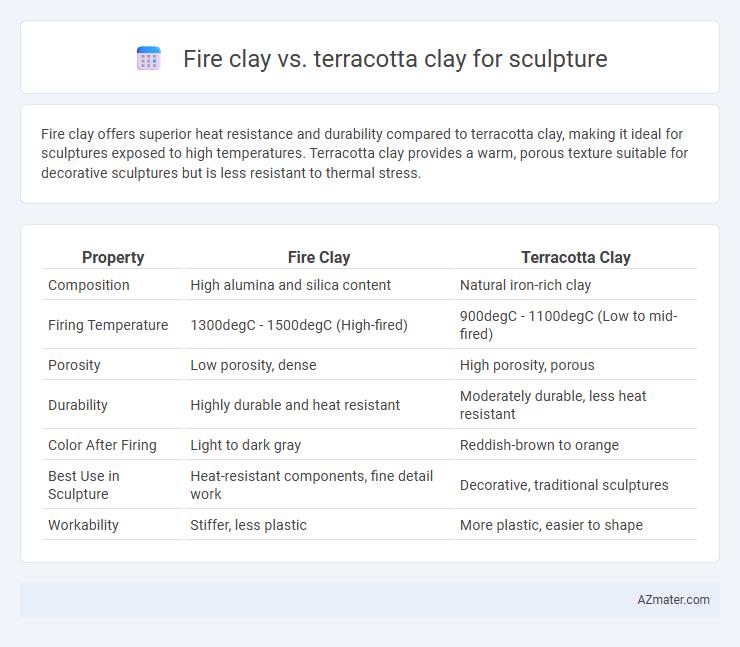Fire clay offers superior heat resistance and durability compared to terracotta clay, making it ideal for sculptures exposed to high temperatures. Terracotta clay provides a warm, porous texture suitable for decorative sculptures but is less resistant to thermal stress.
Table of Comparison
| Property | Fire Clay | Terracotta Clay |
|---|---|---|
| Composition | High alumina and silica content | Natural iron-rich clay |
| Firing Temperature | 1300degC - 1500degC (High-fired) | 900degC - 1100degC (Low to mid-fired) |
| Porosity | Low porosity, dense | High porosity, porous |
| Durability | Highly durable and heat resistant | Moderately durable, less heat resistant |
| Color After Firing | Light to dark gray | Reddish-brown to orange |
| Best Use in Sculpture | Heat-resistant components, fine detail work | Decorative, traditional sculptures |
| Workability | Stiffer, less plastic | More plastic, easier to shape |
Introduction to Fire Clay and Terracotta Clay
Fire clay, a highly refractory and durable material, withstands intense heat, making it ideal for sculptural works requiring heat resistance and structural strength. Terracotta clay, composed of naturally occurring iron-rich clays, offers a warm, reddish-brown finish and easy workability, favored for traditional and decorative sculptures. Both clays serve distinct sculptural purposes, with fire clay excelling in kiln-fired, high-temperature applications and terracotta prized for its earthy aesthetic and versatility.
Composition and Natural Sources
Fire clay contains a high concentration of alumina and silica, originating from weathered volcanic ash and sedimentary rocks, making it highly refractory and ideal for heat-resistant sculptures. Terracotta clay, rich in iron oxide and derived primarily from natural clay deposits enriched by iron minerals, offers excellent plasticity and a characteristic reddish hue after firing. Understanding the mineralogical composition and geological formation of these clays helps sculptors select the material best suited for durability and aesthetic qualities in their work.
Physical Properties Comparison
Fire clay exhibits higher refractory properties withstanding temperatures above 1,500degC, making it ideal for sculptures exposed to intense heat. Terracotta clay, fired at lower temperatures around 1,000degC to 1,150degC, offers a porous and less dense structure, resulting in lighter and more brittle sculptures. Fire clay's superior plasticity and durability enhance sculptural detail and longevity compared to the more fragile and absorbent terracotta.
Workability and Sculpting Techniques
Fire clay exhibits superior workability compared to terracotta clay due to its higher plasticity and resistance to cracking during intricate sculpting techniques. Terracotta clay, while easier to carve when leather-hard, tends to shrink more and requires careful moisture management to avoid warping. Sculptors often prefer fire clay for detailed modeling and complex textures, whereas terracotta suits broader, more robust forms.
Firing Temperatures and Processes
Fire clay, known for its high alumina content, typically fires at temperatures between 1,200degC and 1,400degC, making it ideal for sculptures requiring durability and heat resistance. Terracotta clay, firing at lower temperatures around 900degC to 1,100degC, offers a porous texture and warm reddish tones but is less heat-resistant and more fragile. The firing process for fire clay involves slow cooling to enhance strength, while terracotta's quicker firing cycle suits decorative, low-impact art pieces.
Durability and Longevity in Sculptures
Fire clay offers superior durability and longevity for sculptures due to its high refractory properties, allowing it to withstand extreme temperatures and resist cracking over time. Terracotta clay, while favored for its warm color and ease of shaping, is more porous and less durable, making it susceptible to weathering and damage if not properly sealed. Sculptors prioritizing long-lasting, structurally sound pieces often choose fire clay for outdoor and high-stress applications.
Color and Surface Finish Differences
Fire clay typically has a higher iron content, resulting in a natural gray to buff color after firing, while terracotta clay is rich in iron oxide, giving sculptures a distinctive reddish-orange hue. Fire clay produces a denser, more durable surface finish with a slightly coarse texture, suitable for fine detailing and structural stability. Terracotta clay offers a porous, matte surface that is ideal for rustic, earthy finishes but may require sealing for durability in outdoor sculptures.
Suitability for Outdoor vs Indoor Sculptures
Fire clay offers exceptional durability and high temperature resistance, making it highly suitable for outdoor sculptures exposed to harsh weather conditions and temperature fluctuations. Terracotta clay, while favored for its warm, earthy tones and ease of molding, is more porous and less resistant to moisture, rendering it ideal primarily for indoor sculptures or protected outdoor settings. Artists choosing between these clays should consider fire clay for longevity and structural integrity outdoors, whereas terracotta suits detailed, decorative indoor pieces where environmental exposure is minimal.
Cost and Accessibility for Artists
Fire clay offers higher heat resistance and durability, making it suitable for functional ceramics, but it typically costs more and can be harder to source for artists due to limited availability in specialized suppliers. Terracotta clay, characterized by its affordability and widespread accessibility, is ideal for sculptors seeking a traditional, earthy texture, making it a popular choice for beginners and large-scale works. Artists prioritizing budget and ease of purchase often prefer terracotta for accessibility, whereas fire clay appeals to those needing longevity and structural strength despite higher expenses.
Choosing the Right Clay for Your Sculpture
Fire clay offers high heat resistance and durability, making it ideal for sculptures requiring strength and longevity, especially in kiln-fired or outdoor environments. Terracotta clay provides a warm, reddish-orange hue and is easier to work with for fine details but is more porous and less durable when unglazed. Selecting the right clay depends on the sculpture's intended use, desired finish, and firing method, with fire clay suited for robust, high-temperature processes and terracotta favored for aesthetic qualities and hand-building techniques.

Infographic: Fire clay vs Terracotta clay for Sculpture
 azmater.com
azmater.com